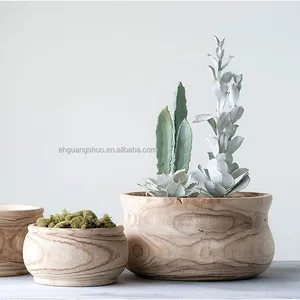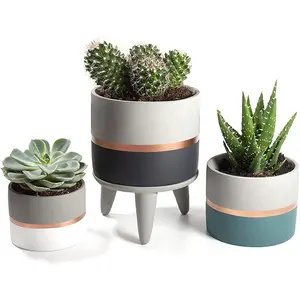Popular in your industry
































































Related Searches:

















































































































Top categories
About planter pot with wood stand
Introduction
In the world of interior and exterior design, planter pots with wood stands have emerged as a versatile and stylish solution to bring nature into our living spaces. These unique pieces blend the rustic charm of wood with the functionality of various planter materials, creating a harmonious balance between nature and style. This article delves into the appeal of these planter pots, the different types available, and how to choose the right wood stand. We also explore the importance of maintenance and care to ensure the longevity of your planter pots and wood stands.
The Appeal of Planter Pots with Wood Stands
Planter pots with wood stands have gained popularity for their ability to add a natural contrast to any space. They fit just about anywhere, making them ideal for small spaces. Wood stands are rustproof and unaffected by humidity, adding another natural element to the space. They can serve as a focal point in the room, holding your plant babies and sprouting a beautiful, modern aesthetic. Whether you're looking to brighten up a tiny room or add some freshness to your office space, planter pots with wood stands offer a versatile solution.
Types of Planter Pots with Wood Stands
Planter pots with wood stands can be made from various materials, each offering unique advantages. Fiberglass planters are modern, durable, and lightweight, ideal for both indoor and outdoor use. Concrete planters, heavy and hardy, are perfect for outdoor spaces and can be customized in various shapes and sizes. Plastic planters are cost-effective and lightweight, but they may not be as durable as other materials. Terracotta and ceramic planters offer a rustic appeal and are quite durable, though they can be heavy and prone to cracking. Each material can complement the aesthetic of a wood stand, creating a perfect blend of nature and style.
Ceramic Planter Pots
Ceramic planter pots offer numerous benefits for your plants. They come in a variety of shapes, sizes, and designs, providing aesthetic value and character. Ceramic pots are durable, able to support top-heavy plants due to their weight and substance. They facilitate advanced moisture and airflow, even when glazed, creating a healthy environment for plant growth. Ceramic pots also maintain temperature effectively, shielding plants from sudden temperature shifts. Suitable for both indoor and outdoor use, they are often waterproof, preventing leaks in your home.
Metal Planter Pots
Metal planter pots, known for their durability and minimal maintenance, are a practical choice for your gardening needs. Crafted from robust materials like corten or galvanised steel, they withstand various conditions, including harsh weather and high traffic environments. Their design versatility is evident in the broad spectrum of styles, shapes, and sizes available. From square metal containers for succulents to round pots for blooming flowers, there's a metal planter to match every vision. They seamlessly fit into various outdoor design schemes, enhancing your chosen aesthetic with their clean lines and contemporary appeal.
Glass Planter Pots
Glass planter pots, specifically fiberglass planters, offer a blend of durability and aesthetic appeal. Constructed from high-quality glass fiber, these planters are finished with UV-resistant epoxy automotive paint, ensuring they don't degrade when exposed to sun or heat. They are lightweight, making them easy to move, yet strong enough to hold large plants and trees. Their modern appearance, with a smooth, matte or gloss finish, enhances any space. Furthermore, they are weather-resistant, capable of withstanding heat, cold, snow, and rain, making them a reliable choice for both indoor and outdoor use.
Choosing the Right Wood Stand
Choosing the right wood stand for your planter pot involves considering the type of wood. Maple is recommended if you plan to stain your wood, while rift sawn oak is also a good choice. However, avoid pine as it doesn't stain well and dents easily. Poplar is another option, although it doesn't stain well, it takes paint nicely. If you're not a fan of the layered look of plywood, you can use matching iron-on veneer banding. Remember, the type of wood you choose can significantly impact the aesthetics and durability of your planter pot stand.
Factors to Consider
When choosing a plant stand, height is a crucial factor. Often, plants need to be near a window or light source, and the closer they are, the happier they'll be. Tall plant stands, such as wooden, metal, or ceramic pedestals, are ideal. It's important that the base of tall stands be heavy and sturdy as they can quickly become top heavy with a terracotta or ceramic pot. Another functional perk of a good plant stand is multiple tiers, which can accommodate numerous plants and give a staggered look to a room.
Popular Wood Types
When choosing the wood for your planter pot stand, consider the wood species. Maple is a good choice if you plan to stain your wood. Rift sawn oak is also a good option, but quarter sawn oak, which is more common in lumber yards, has a busy grain that may not be to everyone's liking. Pine is not recommended as it doesn't stain well and dents easily. Poplar is another option, although it doesn't stain well, it does take paint nicely. If you're not a fan of the layered look of plywood, you can use matching iron-on veneer banding.
Maintaining Your Planter Pots and Wood Stands
Maintaining your planter pots and wood stands is crucial for their longevity. Regular cleaning is essential to keep them looking their best. Check the water supply and drainage to ensure the health of your plants and the durability of the stand. Protect your stand from weather extremes to prevent damage. For wooden stands, wipe down the surface every few days to remove dust or dirt. Fill any cracks or dents to maintain the stand's integrity. Avoid using harsh chemicals that can damage the wood, and protect the stand from harmful UV rays.
Cleaning and Care Tips
Maintaining your planter pots and wood stands involves thorough cleaning to prevent disease spread. Plant pathogens can transfer to plants through soil and plant debris on your tools or pots. Even if your tools look clean, microscopic pathogens may still be present. Remove all visible soil and plant debris before disinfection. Use disinfectants that eliminate bacteria, fungi, and viruses without corroding metal or damaging fabric. However, avoid using it on polished wood, painted surfaces, or acrylic plastics. Always wear personal protective equipment when using disinfectants.
Preventing Damage and Prolonging Lifespan
Planter care is crucial for prolonging the lifespan of your planter pots with wood stands. Regular removal of mineral buildup or other marks and debris on your containers is essential as these can harbor diseases harmful to your plants. The care varies according to the size and material of the pot. For wooden planters, more care is needed than pots made from synthetic materials. It's important to prevent damp from causing rot in wooden stands. Following these maintenance tips will ensure the longevity of both the container and your vegetation.
Conclusion
Planter pots with wood stands offer a unique blend of nature and style, adding a touch of freshness to any space. With a variety of materials available, from ceramic to metal and glass, there's a planter pot to suit every aesthetic. Choosing the right wood stand is crucial, with factors such as wood type, height, and design playing a significant role. Regular maintenance, including cleaning and care, is essential to prolong the lifespan of your planter pots and wood stands. By understanding these elements, you can create a beautiful, modern aesthetic in your home or office, showcasing your plant babies in the best possible way.














































































